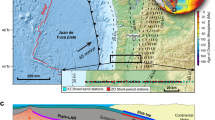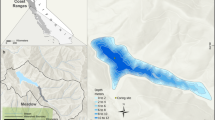Abstract
Subsurface coherent vortices called Meddies1 are formed by the outflow of salty water from the Mediterranean Sea1,2 into the North Atlantic. In October 1984 we began a study to observe the life history and large-scale changes of a Meddy by identifying a specific Meddy, and carefully mapping it and seeding it with Sofar floats3. (These neutrally buoyant floats are tracked acoustically and can be located aboard ship.) As this Meddy moved southward across the Madeira Abyssal plain, it was resurveyed three more times during a span of two years. Being able to find this same lens (100km in diameter) on successive surveys was itself a unique achievement that allowed us to observe the Meddy evolution and to gain new insight into the importance of different mixing mechanisms that cause Meddy decay. We find evidence of mixing by at least three processes: (1) lateral mixing by the exchange of layers of water ('thermohaline intrusions')4,5, (2) vertical mixing at the underside of the lens by salt fingers6 and (3) mixing by turbulence. Together these cause the net heat and salt anomalies to decay with an e-folding time of about one year. Despite the mixing, the relative vorticity at the core remained constant for the first year and the Meddy retained its coherent shape over a two-year period.
This is a preview of subscription content, access via your institution
Access options
Subscribe to this journal
Receive 51 print issues and online access
$199.00 per year
only $3.90 per issue
Buy this article
- Purchase on Springer Link
- Instant access to full article PDF
Prices may be subject to local taxes which are calculated during checkout
Similar content being viewed by others
References
McDowell, S. E. & Rossby, H. T. Science 202, 1085–1087 (1978).
Armi, L. & Zenk, W. J. phys. Oceanogr. 14, 1560–1576 (1984)
Rossby, T., Voörhis, A. O. & Webb, D. J. mar. Res. 33, 355–382 (1975).
Stern, M. E. Deep Sea Res. 14, 747–753 (1967).
McIntyrè, M. E., Geophys. Fluid Dyn. 1, 19–57 (1970).
Turner, J. S. Buoyancy Effects in Fluids (Cambridge University Press, 1973).
Hebert, D. thesis, Dalhousie Univ. 1988).
McWilliams, J. C. Rev. Geophys. 23, 165–182 (1984).
Käse, R. H. & Zenk, W. J. phys. Oceanogr. 17, 158–163 (1987).
Oäkey, N. S. Oceans '87 Proc. Mar. Tech. Soc. 316–321 (1987).
Spain, P. F., Dorson, D. L. & Rossby, H. T. Deep Sea Res. 28A, 1553–1567 (1981).
Killworth, P. D. J. phys. Oceanogr. 16, 709–716 (1986).
Gründlingh, M. L. Meteor Forsch.-Ergebnisse A/B 23, 15–46 (1981).
Rossby, H. T. Eddies in Marine Science (ed. Robinson, A. R,) (Springer, Berlin, 1983).
Author information
Authors and Affiliations
Rights and permissions
About this article
Cite this article
Armi, L., Hebert, D., Oakey, N. et al. The history and decay of a Mediterranean salt lens. Nature 333, 649–651 (1988). https://doi.org/10.1038/333649a0
Received:
Accepted:
Issue Date:
DOI: https://doi.org/10.1038/333649a0
This article is cited by
-
Remote impact of blocking highs on the sudden track reversal of tropical cyclones
Advances in Atmospheric Sciences (2015)
-
Rotifer Population Dynamics in Two Coupled Habitats: Invasion of Chaos
Biological Invasions (2005)
-
Chaos and regular dynamics in model multi-habitat plankton-fish communities
Journal of Biosciences (2001)
-
Mechanisms of the southward translation of meddies
Journal of Oceanography (1998)
-
Submarine salt lenses
Nature (1988)
Comments
By submitting a comment you agree to abide by our Terms and Community Guidelines. If you find something abusive or that does not comply with our terms or guidelines please flag it as inappropriate.



